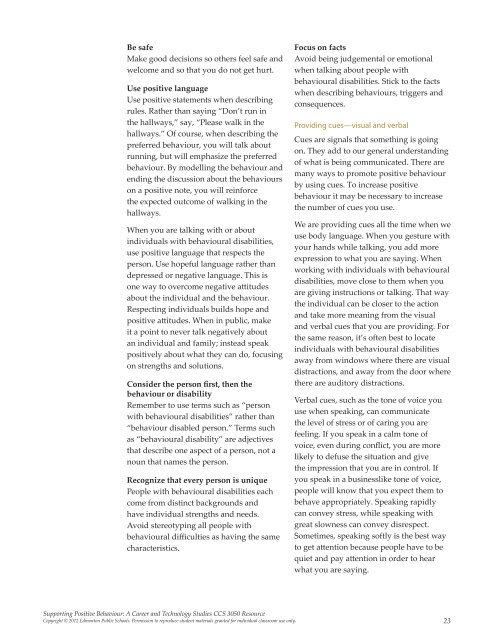Download - Edmonton Public Schools
Download - Edmonton Public Schools
Download - Edmonton Public Schools
You also want an ePaper? Increase the reach of your titles
YUMPU automatically turns print PDFs into web optimized ePapers that Google loves.
Be safeMake good decisions so others feel safe andwelcome and so that you do not get hurt.Use positive languageUse positive statements when describingrules. Rather than saying “Don’t run inthe hallways,” say, “Please walk in thehallways.” Of course, when describing thepreferred behaviour, you will talk aboutrunning, but will emphasize the preferredbehaviour. By modelling the behaviour andending the discussion about the behaviourson a positive note, you will reinforcethe expected outcome of walking in thehallways.When you are talking with or aboutindividuals with behavioural disabilities,use positive language that respects theperson. Use hopeful language rather thandepressed or negative language. This isone way to overcome negative attitudesabout the individual and the behaviour.Respecting individuals builds hope andpositive attitudes. When in public, makeit a point to never talk negatively aboutan individual and family; instead speakpositively about what they can do, focusingon strengths and solutions.Consider the person first, then thebehaviour or disabilityRemember to use terms such as “personwith behavioural disabilities” rather than“behaviour disabled person.” Terms suchas “behavioural disability” are adjectivesthat describe one aspect of a person, not anoun that names the person.Recognize that every person is uniquePeople with behavioural disabilities eachcome from distinct backgrounds andhave individual strengths and needs.Avoid stereotyping all people withbehavioural difficulties as having the samecharacteristics.Focus on factsAvoid being judgemental or emotionalwhen talking about people withbehavioural disabilities. Stick to the factswhen describing behaviours, triggers andconsequences.Providing cues—visual and verbalCues are signals that something is goingon. They add to our general understandingof what is being communicated. There aremany ways to promote positive behaviourby using cues. To increase positivebehaviour it may be necessary to increasethe number of cues you use.We are providing cues all the time when weuse body language. When you gesture withyour hands while talking, you add moreexpression to what you are saying. Whenworking with individuals with behaviouraldisabilities, move close to them when youare giving instructions or talking. That waythe individual can be closer to the actionand take more meaning from the visualand verbal cues that you are providing. Forthe same reason, it’s often best to locateindividuals with behavioural disabilitiesaway from windows where there are visualdistractions, and away from the door wherethere are auditory distractions.Verbal cues, such as the tone of voice youuse when speaking, can communicatethe level of stress or of caring you arefeeling. If you speak in a calm tone ofvoice, even during conflict, you are morelikely to defuse the situation and givethe impression that you are in control. Ifyou speak in a businesslike tone of voice,people will know that you expect them tobehave appropriately. Speaking rapidlycan convey stress, while speaking withgreat slowness can convey disrespect.Sometimes, speaking softly is the best wayto get attention because people have to bequiet and pay attention in order to hearwhat you are saying.Supporting Positive Behaviour: A Career and Technology Studies CCS 3050 ResourceCopyright © 2012 <strong>Edmonton</strong> <strong>Public</strong> <strong>Schools</strong>. Permission to reproduce student materials granted for individual classroom use only.23


